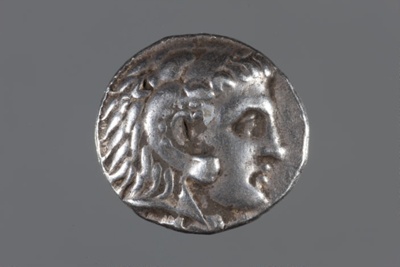< Collection search
< Collection highlights
From:UC Teece Museum of Classical Antiquities
Name/TitleCoin, silver tetradrachm, Alexander the Great
About this objectThis tetradrachm was minted during the latter years of Alexander the Great’s kingship. The coin was produced on the island of Cyprus, which Alexander conquered in 333 BC. Having previously been ruled at different time periods by Assyria and Persia, Cyprus came to be heavily influenced by Greek culture and religion.
The obverse side of this coin depicts the head of a beardless Heracles wearing a lion skin. On the reverse, Zeus is seated on an elaborate throne. He holds an eagle in his right hand and a sceptre in his left, which were powerful symbols associated with the god. Around the image are the inscribed words, ALEXANDROU BASILEŌS, meaning “King Alexander”.
Alexander was said to have made claims that he was the son of Zeus. Some sources suggest that the Oracle of Siwa informed Alexander of this fact. Others suggest that Alexander’s mother Olympias believed she had been impregnated by Zeus in the form of a serpent. Nevertheless, Alexander’s association with the god was propagandist in its connotations of supreme power.
Date MadeLate 4th Century BC
PeriodLate Classical
Place MadeCyprus
Place NotesKition Mint
Medium and MaterialsMetal; Silver
Inscription and MarksΑΛΕΞΑΝΔΡΟΥ - ΒΑΣΙΛΕΩΣ (ALEXANDROU - BASILEŌS) and KT mint mark, all on reverse side
TechniqueStriking (metalworking)
TechniqueInscriptions
MeasurementsWeight 16.99g
Diameter ca. 25mm
Subject and Association KeywordsAnimals in art
Subject and Association KeywordsInscriptions, Greek
Subject and Association KeywordsGods in art
Subject and Association KeywordsArt and mythology
Named CollectionThe James Logie Memorial Collection, University of Canterbury, New Zealand
Credit LineDonated by Rosemary Tredgold, in thanks to Kate and Sam Adshead, 2006
Object TypeExchange Media
Object number202.06.3
Copyright LicenceAll rights reserved


